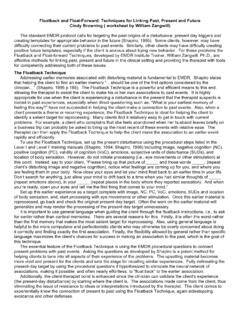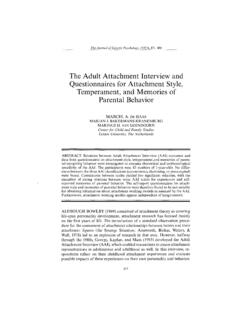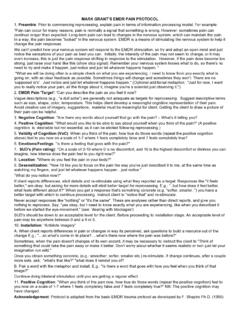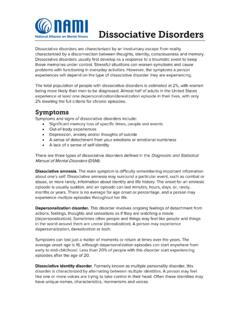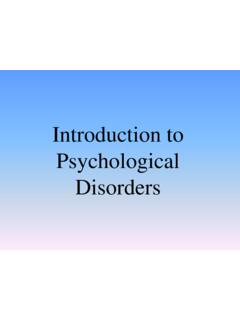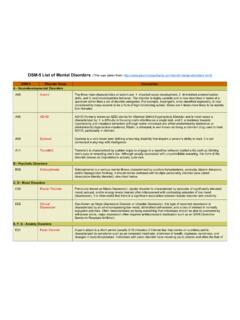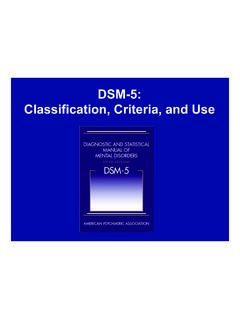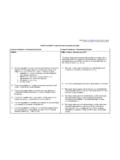Transcription of CHILD DISSOCIATIVE CHECKLIST - emdrtherapyvolusia.com
1 CHILD DISSOCIATIVE CHECKLIST . ( 2/90). Frank W. Putnam, Unit on DISSOCIATIVE disorders , LDP, NIMH. Date: _____ Age: _____ Sex: M F Identification: _____. Below is a list of behaviors that describe children. For each item that describes your CHILD NOW. or WITHIN THE PAST 12 MONTHS, please circle 2 if the item is VERY TRUE of your CHILD . Circle 1 if the time is SOMEWHAT or SOMETIMES TRUE of your CHILD . If the item is NOT TRUE of your CHILD , circle 0. 0 1 2 1. CHILD does not remember or denies traumatic or painful experiences that are known to have occurred. 0 1 2 2. CHILD goes into a daze or trance-like state at times or often appears spaced- out . Teachers may report that he or she daydreams' frequently in school. 0 1 2 3. CHILD shows rapid changes in personality.
2 He or she may go from being shy to being outgoing, from feminine to masculine, from timid too aggressive. 0 1 2 4. CHILD is unusually forgetful or confused about things that he or she should know, may forget the names of friends, teachers or other important people, loses possessions or gets lost easily. 0 1 2 5. CHILD has a very poor sense of time. He or she loses track of time, many think that it is morning when it is actually afternoon, gets confused about what day it is, or becomes confused about when something happened. 0 1 2 6. CHILD shows marked day-to-day or even hour-to-hour variations in his or her skills, knowledge, food preferences, athletic abilities, changes in handwriting, memory for previously learned information such as multiplication tables, spelling, use of tools or artistic ability.
3 0 1 2 7. CHILD shows rapid regressions in age-level of behavior, a twelve year-old starts to use baby-talk, sucks thumb or draws like a four year-old. 0 1 2 8. CHILD has a difficult time learning from experience, explanations, normal discipline or punishment do not change his or her behavior. 0 1 2 9. CHILD continues to lie or deny misbehavior even when the evidence is obvious. 0 1 2 10. CHILD refers to him or herself in the third person ( as she or her) when talking about self, or at times insists on being called by a different name. He or she may also claim that things that he or she did actually happened to another person. 0 1 2 11. CHILD has rapidly changing physical complaints such as headache or upset stomach. For example, he or she may complain of a headache one minute and seem to forget all about it the next.
4 0 1 2 12. CHILD is unusually sexually precocious and may attempt age-inappropriate sexual behavior with other children or adults. 0 1 2 13. CHILD suffers from unexplained injuries or may even deliberately injure self at times. 0 1 2 14. CHILD reports hearing voices that talk to him or her. The voices may be friendly or angry and may come from imaginary companions or sound like the voices of parents, friends or teachers. 0 1 2 15. CHILD has a vivid imaginary companion or companions. CHILD may insist that the imaginary companion(s) is responsible for things that he or she has done. 0 1 2 16. CHILD has intense outbursts of anger, often without apparent cause and may display unusual physical strength during these episodes. 0 1 2 17.
5 CHILD sleepwalks frequently. 0 1 2 18. CHILD has unusual nighttime experiences, may report seeing ghosts or that things happen at night that he or she can't account for ( broken toys, unexplained injuries.). 0 1 2 19. CHILD frequently talks to him or herself, may use a different voice or argue with self at times. 0 1 2 20. CHILD has two or more distinct and separate personalities that take control over the CHILD 's behavior. Journal of CHILD Sexual Abuse, 18:93 102, 2009. Copyright Taylor & Francis Group, LLC. ISSN: 1053-8712 print/1547-0679 online DOI: MEASUREMENT ISSUES. 1547-0679. 1053-8712. WCSA. Journal of CHILD Sexual Abuse, Abuse Vol. 18, No. 1, December 2008: pp. 1 16. Pathological Dissociation as Measured by the CHILD DISSOCIATIVE CHECKLIST JEFFREY N.
6 WHERRY, DEBRA A. NEIL, and TAMARA N. TAYLOR. Pathological J. Dissociation N. Wherry et al. Abilene Christian University, Abilene, Texas, USA. Downloaded By: [EBSCOHost EJS Content Distribution] At: 19:23 8 June 2009. The component structure of the CHILD DISSOCIATIVE CHECKLIST was examined among abused children. A factor described as patholog- ical dissociation emerged that was predicted by participants being male. There also were differences in pathological dissociation between groups of sexually abused and physically abused chil- dren. Replication of this factor and the establishment of base rates for various groups of children are recommended so that the CHILD DISSOCIATIVE CHECKLIST might be used to more effectively eliminate false positives and increase true positives in the screening and ultimate treatment of DISSOCIATIVE children.
7 KEYWORDS CHILD abuse, dissociation, assessment, diagnosis Dissociation has been described by Putnam, Helmers, and Trickett (1993) as a psychophysiological process occurring along a continuum from minor normative dissociations ( , daydreaming) to psychiatric conditions such as DISSOCIATIVE identity disorder (DID). Studies of patients with DISSOCIATIVE disorders yield a high percentage of cases (85 100%) with reported traumatic childhoods (Coons, Bowman, & Milstein, 1988; Putnam, Guroff, Silberman, Barban, & Post, 1986) and CHILD abuse (Chu & Dill, 1990). More- over, dissociation is significantly correlated with severity of trauma, with the magnitude of correlations ranging from approximately .25 to .45 (Anderson, Received 26 September 2006; revised 17 January 2007; accepted 6 May 2008.)
8 This research was supported by grant number 5-R01-MH48784-04 awarded to Roscoe Dykman, PhD, from the National Institute of Mental Health. Address correspondence to Jeffrey N. Wherry, Human Development and Family Studies, Box 41230, Texas Tech University, Lubbock, TX 79409-1230. E-mail: 93. 94 J. N. Wherry et al. Yasenik, & Ross, 1993; Branscomb, 1991; Carlson & Rosser-Hogan, 1991;. Chu & Dill, 1990; Kirby, Chu, & Dill, 1993; Sandberg & Lynn, 1992). As noted, dissociation appears related to the severity of trauma, but it also is predicted by age, gender, duration, and the nature of the sexual abuse. That is, dissociation as measured by the CHILD DISSOCIATIVE CHECKLIST (CDC; Bernstein & Putnam, 1986) and the Trauma Symptom CHECKLIST for Children (TSCC; Briere, 1996) was predicted by being older, being female, by abuse occurring over a longer period of time, and the nature/severity of sexual abuse (Friedrich, Jaworski, Huxsahl, & Bengston, 1997).
9 Confirma- tion of DISSOCIATIVE symptomatology in a CHILD client is relatively uncommon (Kluft, 1984, 1985; Putnam, 1991; Vincent & Pickering, 1988) despite acknowledgement that multiple personality disorder (MPD) or DID often originate in childhood. In fact, less than 3% of the diagnoses of a dissocia- Downloaded By: [EBSCOHost EJS Content Distribution] At: 19:23 8 June 2009. tive disorder are made in children under 12, and less than 8% are made in adolescents between the ages of 12 and 19 (Kluft, 1984). Putnam (1997) reviewed two models for understanding both normal and pathological dissociation. The continuum model holds that dissociation is a normally distributed spectrum of experiences and behaviors. In contrast, the taxon model posits that normal and pathological dissociation are of a different type.
10 Specifically, pathological dissociation involves expe- riences rarely or never experienced by normal people. Putnam also suggested that normal and pathological dissociation predict developmental trajectories that are fundamentally different. Pathological dissociation is characterized by disruptions in the sense of identity and disturbances of memory (Nemiah, 1980). Similarly, Putnam (1997) describes pathological dissociation as a disturbance in the integrative functions of identity, memory, and consciousness. Dorahy, Lewis, Millar, and Gee (2003) also note that pathological or nonnormative dissociation includes amnesia and depersonalization, where nonpathological dissocia- tion is represented by constructs like imaginative involvement and absorp- tion.



